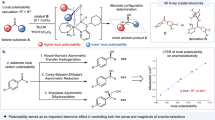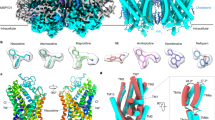Abstract
Easson and Stedman1 have advanced the theory that the differences in biological activity between optical isomers should be considered in exactly the same light as the variations in potency shown by structural isomers. They pointed out that only one optical isomer can come into close contact with the specific receptors, and suggested that the weaker enantiomorph behaves as if one of the active groups is not present at all. In adrenaline, the active groups are : the amino group, the benzene ring with its phenolic hydroxyls, and the alcoholic hydroxyl group. By this view, l-adrenaline can come into complete contact with the receptors, and the weaker enantiomorph, d-adrenaline, cannot. Desoxyadrenaline (epinine) should, therefore, have the same activity as d-adrenaline, except in so far as the activity is modified by changes in physical properties by the presence of the alcoholic hydroxyl group. Easson and Stedman presented evidence that epinine and d-adrenaline do, in fact, have the same effect on blood pressure, and they also found support for the concept in drugs of the miotine type. If the theory is generally true, similar considerations should apply among compounds related to adrenaline : compounds containing a lævo-rotatory B-carbon atom should be the more active, and, with the above reservations regarding physical properties, the activity of the dextro-rotatory enantiomorphs should approximate to that of the desoxy-derivatives.
This is a preview of subscription content, access via your institution
Access options
Subscribe to this journal
Receive 51 print issues and online access
$199.00 per year
only $3.90 per issue
Buy this article
- Purchase on Springer Link
- Instant access to full article PDF
Prices may be subject to local taxes which are calculated during checkout
Similar content being viewed by others
References
Easson, L. H., and Stedman, E., Biochem. J., 27, 1257 (1933).
Schaumann, O., "Medicine in its Chemical Aspects", 3, 361 (1938) (Bayer, Germany).
Alles, G. A., and Knoefel, P. K., Univ. Calif. Pub. Pharmacol., 1, 101 (1938).
Tainter, M. L., J. Pharm. and Exp. Ther., 40, 43 (1930).
Swanson, E. E., Scott, C. C., Lee, H. M., and Chen, K. K., J. Pharm. and Exp. Ther., 79, 329 (1943). Jarowski, C., and Hartung, W. H., J. Org. Chem., 8, 564 (1943).
Tainter, M. L., and Seidenfeld, M. A., J. Pharm. and Exp. Ther., 40, 23 (1930).
Barger, G., and Dale, H. H., J. Physiol., 41, 19 (1910). Barger, G., "Some Applications of Organic Chemistry to Biology and Medicine" (McGraw-Hill, 1930).
Chen, K. K., Wu, C-K., and Henriksen, E., J. Pharm. and Exp. Ther., 36, 363 (1929).
Neeman, M., Nature, 154, 550 (1944)
Author information
Authors and Affiliations
Rights and permissions
About this article
Cite this article
BADGER, G. Molecular Asymmetry and Biological Activity. Nature 159, 194–195 (1947). https://doi.org/10.1038/159194b0
Published:
Issue Date:
DOI: https://doi.org/10.1038/159194b0
This article is cited by
-
The relationship between structure and biological activity: Some fundamental aspects
Ergebnisse der Physiologie Biologischen Chemie und Experimentellen Pharmakologie (1957)
Comments
By submitting a comment you agree to abide by our Terms and Community Guidelines. If you find something abusive or that does not comply with our terms or guidelines please flag it as inappropriate.



